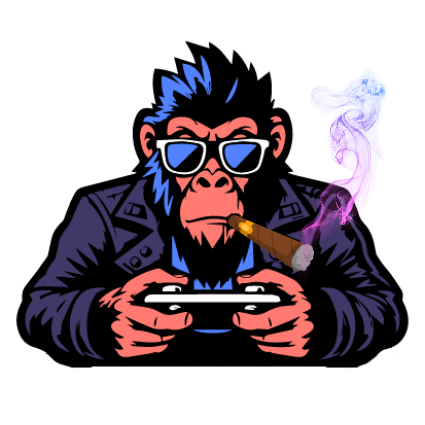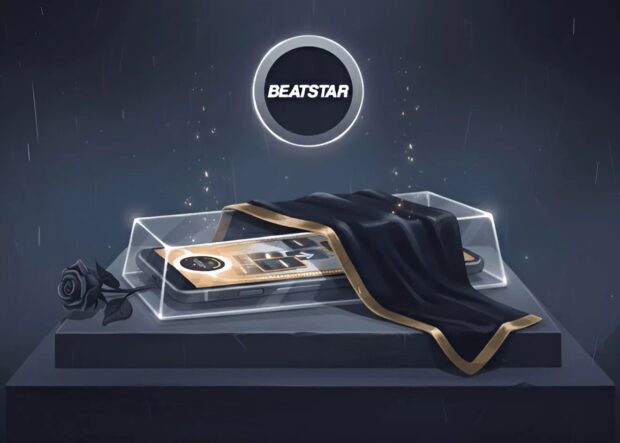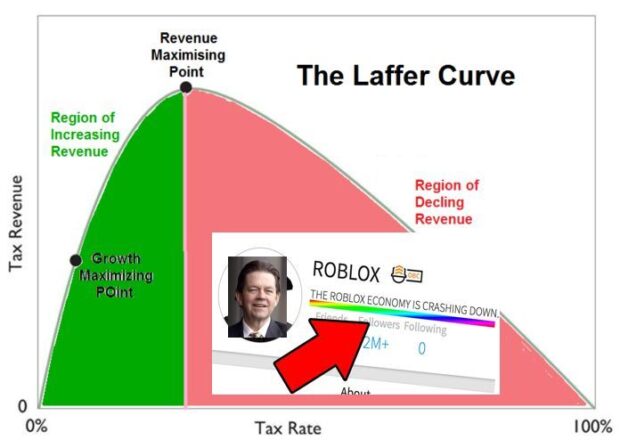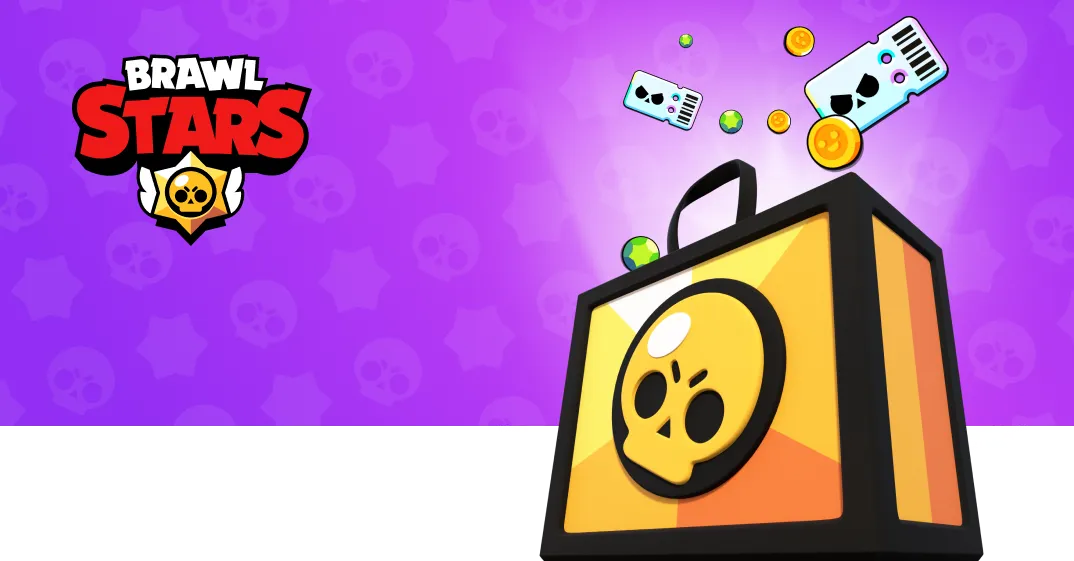
Brawl Stars Shop Design: Mastering Motivation Over Monetization Pressure
AnalysisJournal 76 Joseph Kim June 30
Brawl Stars has continuously evolved since its 2017 launch—removing loot boxes, introducing the Brawl Pass, experimenting with IP collaborations, and refining its core systems. As the game pushes to stabilize its revenue after a small post-peak dip in 2024, one element stands out as a consistent driver: its shop.
This article explores how Brawl Stars’ in-game and webshops are strategically designed to align with player progression, daily engagement, and monetization goals. From layout and offer prioritization to the role of the Brawl Pass and Supercell’s integrated webshop ecosystem, we unpack how the shop serves as both a revenue engine and a player experience touchpoint.
Key Findings:
- Single-track horizontal shop design reduces decision fatigue compared to complex multi-tab systems
- Brawl Pass at $6.99 serves as the primary monetization anchor, leading all IAP sales
- Strategic friction points align with player psychology to create spending motivation, not pressure
- Webshop integration with Supercell ecosystem creates cross-game loyalty and discovery
Gameplay and Progression Serve Monetization
To understand the Brawl Star Shop, let’s understand how Brawl Stars, a casual MOBA, works at a glance.
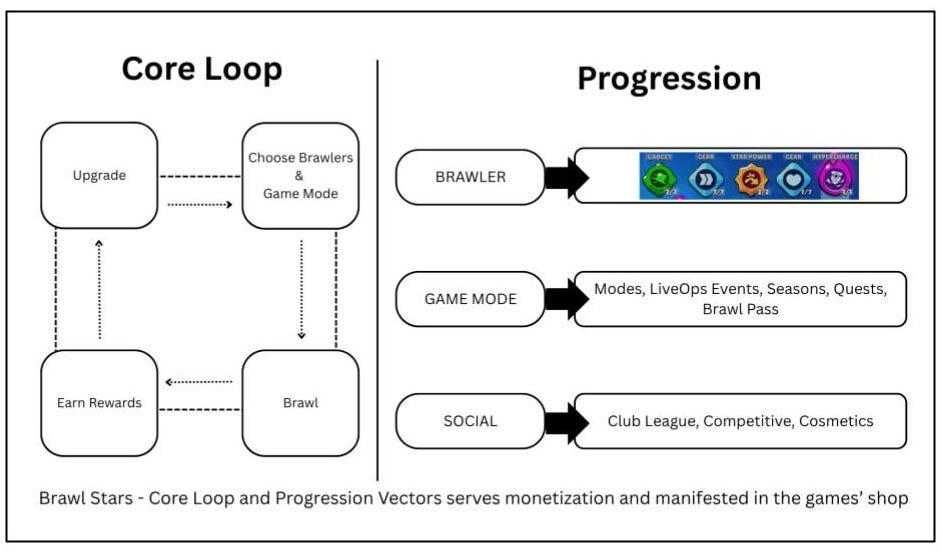
The core loop is simple:
- Players choose a Brawler,
- Select a game mode,
- Enter a match, and
- Earn rewards like coins, tokens, and power points.
These rewards are then used to upgrade Brawlers, making them stronger for the next match. This cycle repeats, keeping players engaged. Each part of this loop presents natural opportunities for the game to introduce shop items that help players progress more quickly or gain an advantage.
The game is built around three main areas that shape how players stay engaged- Brawlers, Game Modes, and Social features
Each of these engagement areas has multiple progression levers. Players can grow stronger Brawlers, complete time-limited events, and earn rewards through club activities. These systems make the game feel deep and rewarding, giving players reasons to log in daily and keep playing and progressing.
The primary progression system in the game is the Brawl Pass. It ties all the pieces together, giving players access to new Brawlers, quests, skins, and special events. It’s the primary seasonal progression system and plays a significant role in keeping players engaged throughout each season. It’s also a key part of the game’s monetization plan.
Now that we understand the gameplay structure and how players progress, let’s take a closer look at how Brawl Stars turns this into revenue.
Monetization Opportunities
Brawl Stars transforms progression into monetization by carefully designing friction points that align with player psychology. Instead of aggressive paywalls, the game introduces subtle gates—limited-time access, token pacing, or currency shortages—that make players want to spend, not feel forced to.
These friction points are intentionally mapped to emotional drivers, such as competitive advantage, collection satisfaction, or convenience. Whether a player is chasing power, cosmetics, or seasonal unlocks, there’s always a clear, relevant offer waiting in the shop.
Below is a structured view of how Brawl Stars connects progression, friction, monetization mechanics, and player psychology:

This framework reveals how Brawl Stars monetizes through motivation, not pressure. It reinforces the idea that the shop isn’t an add-on—it’s an integrated part of the game’s progression design.
Having established these monetization foundations, Brawl Stars implements these strategies through two primary commercial channels: the in-game shop system and the external webshop platform. Each serves distinct functions in converting player engagement into revenue while maintaining the overall quality of user experience that Supercell games are known for. Let’s first analyse the in-game shop.
Brawl Stars’ In-Game Shop – A place for everyone
Brawl Stars’ in-game shop is a unified space designed for all player types—from high spenders to light spenders to non-spenders. It’s placed prominently on the home screen, right above Brawlers tab, ensuring it gets maximum visibility across all player sessions.
The shop is designed to achieve two key goals- convert non-spenders into spenders through daily exposure, free rewards, and low-barrier entry offers and reach spend cap for high-value players through limited-time, high-value bundles and cosmetics
Let’s analyse Brawl Stars’ Shop and how each aspect is designed to achieve above two goals.
- Design- Simplicity Over Complexity
Brawl Stars’ shop design is deliberately simple. It avoids complexity of pop-ups, overlapping tabs, overwhelming SKUs, Offers. The shop focuses on:
- High visibility + low decision fatigue
- Minimal SKUs, high relevance
- Personalised Offers
Compared to games like CODM with 50+ offers running simultaneously, Brawl Stars operates a tight store that converts through focus, not volume.
- Layout- Single Track Horizontal Shop
Brawl Star Shop is designed as a horizontal single track shop which the player will swipe to go to the next shop segment but on the bottom can see all the segments of the shop in one go.
The image below shows the full glossary of this horizontal shop :

- Shop Sections & Priority – Designed for Visibility and Intent
Brawl Stars’ shop is divided into four clearly labeled sections: Offers, Daily Freebie, Cosmetics, and Resources. All segments are displayed in a horizontal tab at the bottom of the shop, allowing players to access them instantly without tab hunting or deep menus.

The order and placement of these sections aren’t random—they reflect strategic monetization intent:
- Offers
This is the highest-priority section and the default landing tab when the shop opens. It always begins with the Brawl Pass, followed by up to six rotating time-limited bundles, including progression boosters, cosmetics, or value packs. These are designed to catch attention and drive immediate spending. - Daily Freebie
Positioned right after Offers, this tab provides one free item per day—coins, pins, or doublers. Once claimed, the next day’s reward is shown but locked, creating a daily ritual that drives repeat visits and increases shop exposure. - Cosmetics
Skins, pins, and sprays rotate here, often linked to seasonal events or Brawler themes. Urgency is created using timers, rarity labels, and visual callouts. These items are non-gameplay-affecting and target collectors and expression-driven players. There are 4 skins shown in this area at a time.The other cosmetics are wrapped in a cosmetics catalogue which player can click knowing that there will be plethora on cosmetics but on the first go, Brawl Stars do not bombard with many cosmetics - Resources
This section includes coin packs, power points, and gear tokens. It’s not aggressively surfaced, and is usually engaged when players actively seek upgrades—indicating intent-based monetization rather than push-based selling. There are 6 coin packs only which helps reduce decision fatigue.
This layout and order reflect a thoughtful balance: surface what matters to most players first (value offers), build routine (freebies), monetize emotion (cosmetics), and support need-based spending (resources).
Shop Sections, SKU & their refresh rate
Brawl Stars’ four shop sections have a mix of static and personalized SKUs. Personalized deals vary by player level and purchase history, while static offers maintain consistency.
Below is a summary of SKU types and their refresh rates:
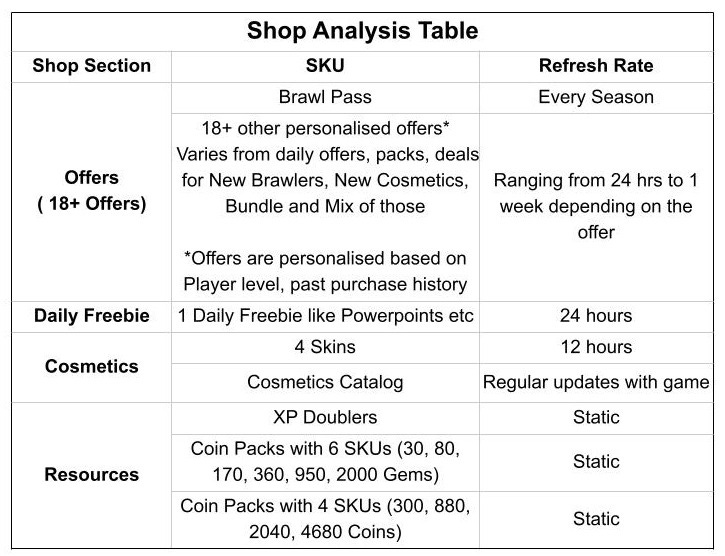
More than half the shop updates regularly, delivering a dynamic, personalized experience. Static SKUs (e.g., cosmetics and resource packs) are placed at the end, while fresh, limited-time offers are placed upfront for better visibility.
- Brawl Pass – The Centerpiece of Monetization
The Brawl Pass sits at the heart of Brawl Stars’ monetization system. As the first item under the Offers tab, it’s given maximum shop visibility and is designed to convert the widest player segment—from non-spenders to light spenders.
Its value proposition is clear:
- Unlocks new Brawlers, exclusive cosmetics, quests, and events
- Sets the rhythm for the season through a linear reward track
- Creates a compelling loop of play → progress → unlock → spend
At a low entry price of $6.99, the Brawl Pass is accessible, scalable, and efficient. It bundles engagement, progression, and monetization into a single seasonal driver—making it easy to justify and habit-forming to renew.
Instead of relying on aggressive monetization tactics like gacha or RNG crates, Brawl Stars anchors spending on predictability, value, and progression alignment. This makes the Brawl Pass not just a product—but the structural foundation of how the shop earns.
- Sales & Merchandising
One of the most striking aspects of Brawl Stars’ shop is how tightly curated its sales and merchandising strategy is. Instead of bombarding players with a flood of options, the game offers limited, high-clarity SKUs—each targeting a specific player need or conversion opportunity.
Fixed, Global Gem Packs
The shop has only six permanent gem packs with global pricing (see table below). These cover a broad spectrum of player budgets without overwhelming choice paralysis.

This clarity in pricing and package design reduces cognitive load and encourages smoother purchase decisions—especially for first-time spenders.
Cosmetic Display – Preview, Don’t Flood
For skins and cosmetic items, the shop displays only 6 skins at a time. The rest are tucked neatly inside a catalogue tab. This strikes a balance: players are enticed by curated highlights without being overwhelmed, but still know there’s more if they choose to explore.
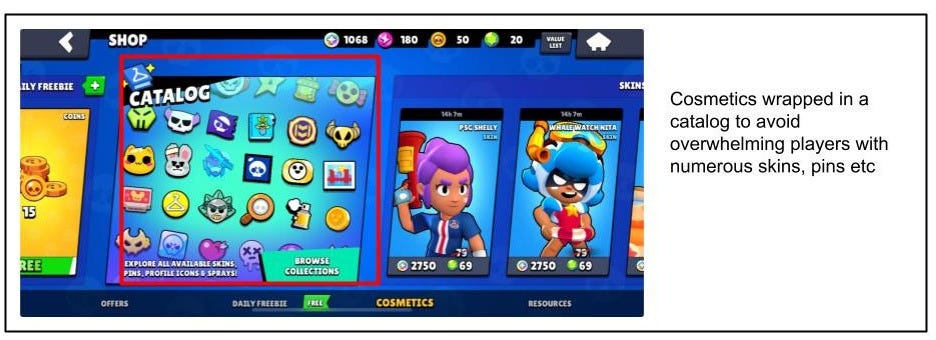
This merchandising strategy respects player time and mirrors real-world retail practices—put the most relevant items on the shelf, let the rest stay discoverable but optional.
First-Time Brawl Pass Conversion – Smart Pricing Nudges
The shop is also designed to increase conversion for the Brawl Pass, the game’s central monetization engine. New or lapsed players (who haven’t purchased the pass in the past 6 months) are presented with a $2.99 limited-time offer for the Brawl Pass—down from its standard price.

This tactic does two things:
- Hooks new spenders with a low-barrier entry point
- Reactivates churned monetizers without undercutting pricing for active players
By bundling sales triggers (timing, visibility, reduced price) with the seasonal progression driver (Brawl Pass), Brawl Stars ensures its merchandising serves long-term engagement goals—not just short-term revenue spikes.
Precision Merchandising: Built for Player Intent
Brawl Stars’ shop isn’t trying to do everything for everyone—it’s smartly segmented. Instead of flooding players with SKUs, it curates offers that align with intent, stage, and motivation. Broadly, the shop speaks to three core player personas:
- Non-Spenders & Light Spenders
Hooked through daily freebies, low-friction Brawl Pass offers, and consistent exposure to limited-time deals designed for first-time purchases. - Progression-Oriented Players
These players hit friction while leveling Brawlers or upgrading gears. The shop surfaces timely bundles—power points, coins, gear tokens—to ease that grind just when motivation peaks. - Collectors & Power Users
Skins, cosmetics, hypercharge bundles, and seasonal exclusives cater to emotional engagement and completionist mindsets. For these players, identity and rarity drive spend.
By anchoring merchandising to these key personas, Brawl Stars ensures the shop always feels relevant—nudging players toward conversion without overwhelming them.
- What IAP Packs are selling
To understand how Brawl Stars monetizes in practice—not just in design—we pulled the top-selling in-app purchase data from AppMagic (iOS, USA). The results reinforce what we’ve observed throughout this analysis:
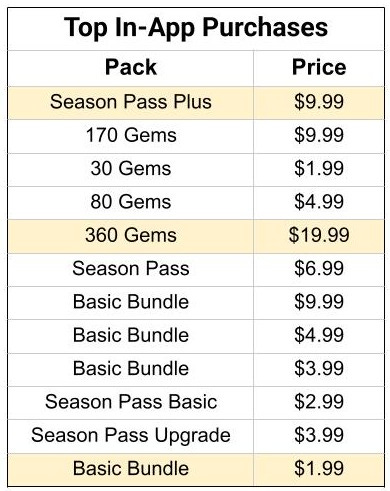
The Season Pass Plus at $9.99 is the top-selling pack, reflecting its strong value through boosted progression and exclusive rewards. Core gem packs like 170 Gems ($9.99) and 80 Gems ($4.99) also rank high, signalling a healthy mix of light and mid-tier spenders. The presence of multiple Basic Bundles at different prices suggests personalized, rotating offers designed to convert fence-sitters or reward returning players.
- Season Pass Plus leads in sales, confirming its role as the game’s flagship monetization anchor.
- Gem packs at varied price points allow flexible entry for different spending appetites.
- Basic Bundles serve as dynamic, behavior-driven SKUs that support onboarding and re-engagement.
Brawl Stars’ Webshop
Now, after the epic verdict (pun intended) which allows webshops to be set up by developers to bypass play store and app stores to save the 30% cut, Supercell has also integrated webshop in the games. Brawl Stars’ webshop is a master class in how webshops should be done for a game and for a game studio.
Integration & Promotion
The Brawl Stars webshop experience isn’t the same for every region. In the U.S., players are nudged toward the webshop as soon as they open the in-game shop—a bold, front-and-center integration that maximizes visibility and frictionless access. (image below)
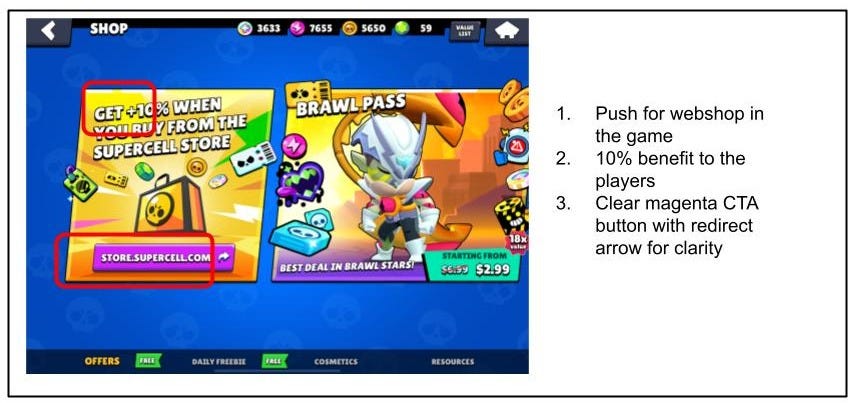
However, in markets like India, this promotion is absent. Players can still access the webshop via browser, but the lack of direct in-game cues adds an unnecessary step that may affect adoption and conversion.
Webshop features & bonus
Brawl Stars’ webshop offers extra features and bonuses to players compared to in-game shop. The header of the webshop promotes 3 major selling points for the players as shown in the following image.

Following are special bonuses Brawl Stars is providing to the players if they purchase via webshop at a glance-
- Free gems every month by completing webshop quests like logging in the webshop
- Webshop specific offers like welcome offer for me
- Webshop bonus for gems (10%) , brawl pass (Up to 30% XP jump)
- Community/eSports team supporting cosmetics (icon and pins)
Brawl Stars’ webshop in Supercell universe
The real genius of the webshop lies in its deeper integration into the Supercell Universe. Every player who logs into any Supercell game is given a Supercell ID—a unified account that acts as a passport across Brawl Stars, Clash Royale, Clash of Clans, and others.
Using this ID, Supercell gamifies purchases and actions across all its titles. Players earn Supercell Points for eligible purchases and quest completions—regardless of the game. These points unlock milestone rewards, and more importantly, players can choose which game they want to claim their rewards in.
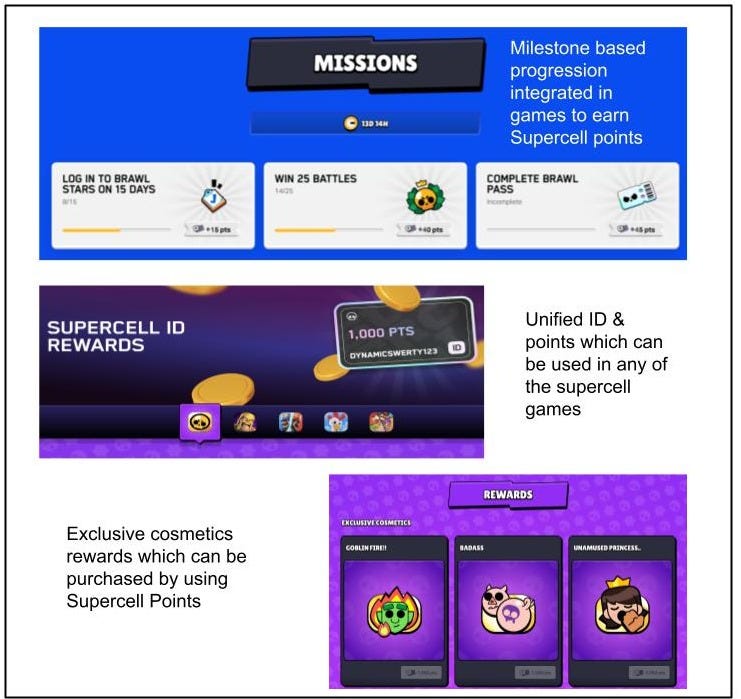
This cross-game flexibility makes the entire Supercell catalog more discoverable and sticky. A player who starts in Brawl Stars can be nudged to return to Clash Royale, or explore Boom Beach, simply through the incentive of redeeming points. It’s a clever retention and cross-sell mechanism that strengthens the overall Supercell economy while giving players a sense of agency and value.
This “one player, many games” strategy is a clear evolution from standalone monetization models. It’s an elegant combination of loyalty program, player retention system, and cross-title discovery funnel—all embedded within the core of Supercell’s webshop strategy.
Conclusion
Brawl Stars’ shop success stems from a fundamental insight: players convert through relevance, not overwhelm. Every design decision—from the horizontal layout to the Brawl Pass pricing to the webshop ecosystem integration—reflects this philosophy.
The shop isn’t just a revenue channel; it’s a player experience touchpoint that builds trust while driving conversion. By focusing on restraint, clarity, and systemic alignment, Brawl Stars has created a monetization engine that works because it respects player time and decision-making capacity.
In an industry often characterized by aggressive monetization tactics, Brawl Stars demonstrates that sustainable success comes from designing systems that players want to engage with, not systems they feel pressured to use. This approach has made the shop not just profitable, but integral to the overall game experience—a lesson that extends far beyond mobile gaming into any product that seeks to convert users while maintaining their trust and engagement.
